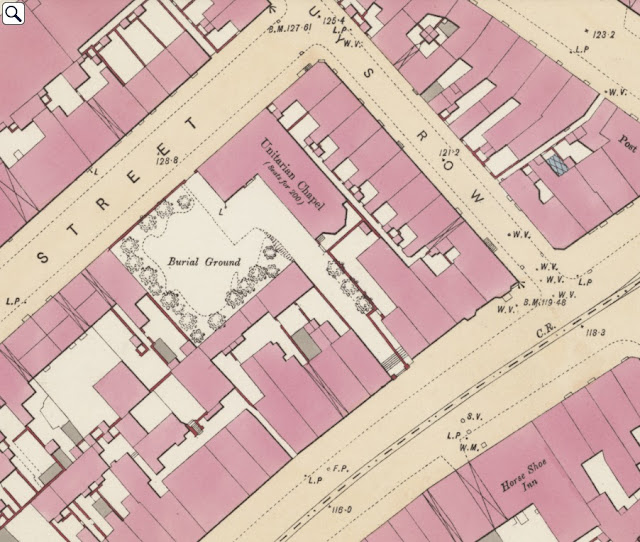Some Old Gates that appear to have survived the War
 |
| Gates Manufactured by W. Dryden of Preston |
I spotted these on Church Street in Preston on Sunday 1st December 2024. I can't say that I have noticed them before. I probably thought that they were just a fence. They would have once acted as an entrance into the former Unitarian Chapel on Percy Street (perhaps formally on Church Street), and its Burial Ground.
 |
| The Former Unitarian Chapel on an Old Ordnance Survey Map |
The map can be found on the National Library of Scotland website. I have included it courtesy of them. Many old maps can be viewed on the website. This view shows the Ordnance Survey map from the mid nineteenth century that I have used compared to a relatively modern satellite image. It is geo-referenced, which mean the features on the map can be matched up and traced side by side with the satellite image.
NLoS:
They were manufactured by W. Dryden of Preston.
 |
| W. Dryden & Sons were Millwrights, Engineers, Iron and Brass Founders |
 |
| W. Dryden & Sons were Millwrights, Engineers, Iron and Brass Founders |
W. Dryden & Sons were Millwrights, Engineers, Iron and Brass Founders. They had a substantial manufacturing site at Grimshaw Street in Preston. They were founded in 1871.
Mr. Wm. Dryden, was general manager at Whittaker’s foundry, Higher Walton, before starting in business on his own account.
He appears to have been born in Scotland in 1820. Records show him as William Dryden age 41 Millwright Scotland in 1861.
William Dryden (iron founder) of Preston died 11th of July 1896
Probate was granted to Janet Dryden spinster (his daughter)
Lancaster 16th of Feb 1897
effects £5775,8s 11d
The business remained in the family for generations. There is a suggestion that it may have taken his son's name later and traded as T. Dryden and Sons.
The succession appears to have been as follows:
William Dryden
Thomas Dryden
William Dryden, Senior
William Dryden, Junior
By 1962 Thomas Dryden and Sons was a subsidiary of Oxley Engineering Co.
 |
| W. Dryden & Sons - Millwrights, Engineers, Iron & Brass Founders. |
 |
| W. Dryden & Sons - Millwrights, Engineers, Iron & Brass Founders |
 |
| W. Dryden & Sons - Millwrights, Engineers, Iron & Brass Founders |
 |
| W. Dryden & Sons - Millwrights, Engineers, Iron & Brass Founders |
 |
| W. Dryden & Sons - Millwrights, Engineers, Iron & Brass Founders |
~
Further reading and sources of information
.
Dryden search of the Preston Digital Archive
https://www.flickr.com/search/?user_id=22711538%40N07&view_all=1&text=Dryden
.
T. Dryden and Sons - Grace's Guide To British Industrial History
https://www.gracesguide.co.uk/T._Dryden_and_Sons
.
W. Dryden & Sons - Grimshaw Street, Preston c.1880 (PDA)
https://www.flickr.com/photos/rpsmithbarney/4559723212/
.
RootsChat.Com » » Dryden of Preston
https://www.rootschat.com/forum/index.php?topic=598908.0
.
FORMER UNITARIAN CHAPEL, CHURCH STREET
Listed on the National Heritage List for England
https://historicengland.org.uk/listing/the-list/list-entry/1209829
.
Comments
Post a Comment